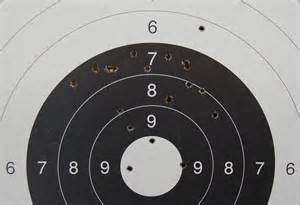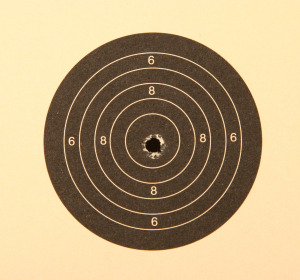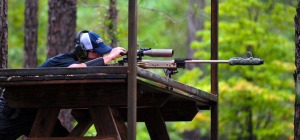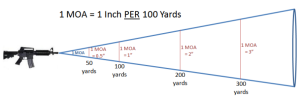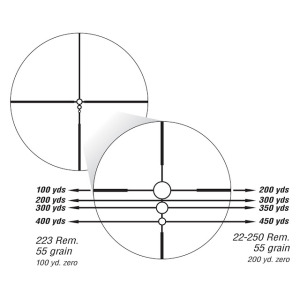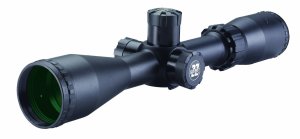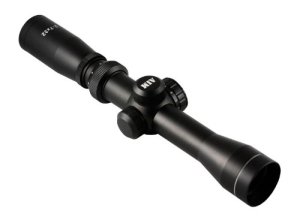Looking at the literal definition of “accuracy” we find accuracy defined as, “freedom from mistake or error.” In addition, accuracy is; “the ability to work or perform without making mistakes.” Accuracy, then, is a comparable value and that means that in order for something to be determined as “accurate” it must be compared to a standard; a metric, if you will.
Here is something for you to use that will interrupt the normal flow of any gun shop (in fact, any business); Ask an associate if you can look at a firearm (of your choosing). Upon receiving the firearm, ask the associate if the firearm is accurate. What is the associate going to say? Of course, the associate is going to say yes! In fact, the firearm may be the most accurate in the shop – ever. Then, ask the associate if he or she can prove that. The bottom line is that they cannot truthfully attest to the accuracy of the firearm.A manufacturer may state that the firearm is the “most inherently accurate firearm ever made.” What was that marketing statement based upon? “The blah, blah firearm was designed and manufactured to produce superior accuracy!” Now, a finely manufactured marketing statement should have every person on the planet clamoring to own that firearm.
I Have Little Tolerance!
I have run across revolvers with barrel-to-cylinder gaps from .002-inch to .012-inches. The tolerance range that I allow for any revolver’s barrel-to-cylinder gap is between .004-inch to .008-inch. Any less than .004-inches or greater than .008-inch means that the revolver remains in the hands of the current owner. That is my standard and I am sticking by it.
The inherent accuracy of any firearm simply reflects the ability of the manufacturer to produce a firearm, part and parcel, to within design specifications. If every part of the firearm is manufactured to meet or exceed the intended specification, then one could say that the “firearm” is accurate “in toto.” Accuracy, in this sense, is not an indicator of how well the firearm will send a bullet downrange or even if it will even do so (insert “exact, non-firing replica” at this point).
I Feel So Accurately Inadequate!
Despite the lack of proof that our selected firearm is indeed “accurate”, we shuffle home with our new and prized possession in hand with high expectations that we will now be able to place a bullet (or bullets) in the center of a target at some distance akin to infinity. We now have an inanimate object that is claimed to be accurate, and place that object in the hands of an accurately inadequate example of Homo sapiens who sometime resorts to Neanderthal behavior during mating season, football season, Black Friday shopping, and when purchasing .22 LR ammunition. From these hands, we are going to wring the most accuracy out of this (allegedly) already accurate accommodation for sending projectiles away from us in a spectacular fashion. Is that not great, or what?
I Am a Little Short Sighted!
With “combat” accuracy essentially meaning simply hitting a target, I would like to be more accurate in what it means to be – hitting a target accurately; placing the sights on a point in the target and expect the bullet to strike within reasonable distance from the point of aim. For the most part, my EDC is zeroed for a distance of 25-yards. In short, this is the distance where I want the point of impact to be equal to the point of aim. At closer distances, I can expect to hold a little higher on the target (about 1” higher than where I want the bullet to strike the target). At longer distances, I know that I will have to compensate for the flight path of the bullet. I consider the weapons system accurate (my EDC and me) if the result of my first shot is within 1” at 7-yards. If I can shoot a 5-round magazine’s worth of bullets in a 3” circle at 7-yards, I consider that precise enough for combat work. I ask no less of the 20-gauge. Is this considered MOA? Not hardly, by the true definition.
I could spend a lifetime trying to achieve MOA with an open-sighted handgun. Put a scope on a handgun meant for hunting, sport, or defense; however, and I step into the MOA, MilDot, and BDC world.
MOA Power to Ya’!
Precision shooting is another world altogether. Not only do our shots need to be accurate, but we need to be able to repeat that accuracy time and time again. As the distance increases, the pocket pistols are returned to the pockets and the long guns come out. Now, just because they are long guns does not mean that they can’t be used for short distances. There are many fine handguns that can reach out and touch someone at long distances if their operator knows what they are doing with them. Long guns, rifles specifically, still rule the roost when it comes to shooting at distance – especially those with magnified optics.
I find rifle scopes to be evil necessities. I dislike them but I need them to make the rifle shoot as accurate as I can. There is nothing more satisfying than placing the crosshairs of a scope in the center of a 100-yard sight-in target and see a hole appear in the target – especially when it is at 100 yards and especially if the hole appears where the crosshairs of the scope were positioned at before it came off target due to recoil. That’s accuracy. Four more shots were fired and the result was a 3.5” group centered on the bulls-eye. This group was out of a pre-cross bolt safety Marlin 336 .30-30 equipped with a 3-9×40 scope. I still have that rifle. It is now equipped with a rear “ghost” site. Now they tell me that the group would have been a little over MOA at 300 yards. So my shooting was sub-par? Then, I read somewhere that one could only expect 4 MOA out of the gun. Wow! I was really bummed out. It wasn’t until I began to understand what MOA was, and I was able to formulate a come back, did I begin to feel better. To the next person that claims that the Marlin 336 .30-30 is a 4 MOA rifle, I will ask them to walk downrange 100 yards, face me, and then take their shirt off. I will aim at your left nipple and fire a shot. Then, come back and tell me that a shot that lands within three and one-half inches from your left nipple is not an effective shot. I think that I will win my argument without firing a shot to prove it.To me, firing a MOA group and not hitting what I intend to hit is a useless exercise.
The scope that I was using at the time is not too much different from the scopes that I have today; they all adjust in ¼” increments with each click of the adjustment. At 100 yards, 4-clicks of adjustment yields 1” of movement on the target. Is that so hard to say? “You are 2 inches left and 4 inches down,” my spotter said. Easy enough to work that one; 8 clicks right and 16 clicks up of adjustment and I’m good to go! Telling me that I am 2 MOA left and 4 MOA down does nothing for me; my scope is adjusted in inches! It might be useful if the scope is marked in MOA, but we both have to be on the same page reading the same book!
The arcminute is commonly found in the firearms industry and literature, particularly concerning the accuracy of rifles, though the industry refers to it as minute of angle or MOA. I refer to it as the “Minute of Angst”, as that is usually what I suffer when trying to achieve it.
MOA seems to be the “in thing” these days with MilDots following up close behind for those who like to talk in the “tactical” sense. However, the MOA system is an easy conversion for those of us who think in inches.One MOA is simply one-inch at 100 yards. If my scope adjustment (clicks) is in fractions of an inch (1 click = 1/4”, my spotter tells me that I need 1MOA right, and I am at 100-yards, I know to dial-in 4-clicks of right windage. In this sense, MOA is relative between the point of aim and point of impact. I know when “accuracy” is achieved as best as the weapons platform can achieve it. Moving to subsequent shots, MOA is a degree of precision. The weapon system can be highly accurate but exhibit poor shot groups, which is matter of MOA. A cluster of hits in a 1” circle at 100 yards is considered MOA.
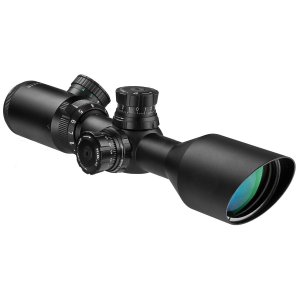
BARSKA 3-9×42 IR 2nd Generation Sniper Riflescope w/MilDot Reticule – Zeroed @ 100 yards on a Windham Weaponry “SRC”
In my neck of the woods, the 100-yard zero is optimum as shots (hunting) are largely taken equal to or less than that distance. In more unrestricted areas, zeroing at greater distances may be more common. Where shots are determined to be taken within 100-yards, a scope that is variable from 2-7 magnification is usually more than adequate with the use of a good red dot sight becoming more popular because the shooter can easily transition to CQB distances quite easily.
Rifle manufacturers and gun magazines often refer to this capability as sub-MOA, meaning it shoots under 1 MOA. This means that a single group of 3 to 5 shots at 100 yards, or the average of several groups, will measure less than 1 MOA between the two furthest shots in the group, i.e. all shots fall within 1 MOA. If larger samples are taken (i.e., more shots per group) then group size typically increases, however this will ultimately average out. If a rifle was truly a 1 MOA rifle, it would be just as likely that two consecutive shots land exactly on top of each other as that they land 1 MOA apart. For 5 shot groups, based on 95% confidence a rifle that normally shoots 1 MOA can be expected to shoot groups between 0.58 MOA and 1.47 MOA, although the majority of these groups will be under 1 MOA. What this means in practice is if a rifle that shoots 1″ groups on average at 100 yards shoots a group measuring .7″ followed by a group that is 1.3″ this is not statistically abnormal. – source: http://www.nssf.org/video/facts/MOA.cfm
MOA is based on the “imperial” system of measurement. Of course, we can’t let that rest when we are talking “tactical” so we revert to its metric counterpart, the MilDot.
That’s so Radical, Dude! (Milling Around the MilDot?)
The Metric System counterpart of the MOA is the MilRad, being equal to one 1000th of the target range, laid out on a circle that has the observer as centre and the target range as radius. The number of MilRads on a full such circle therefore always is equal to 2 x π x 1000, regardless the target range. Therefore 1 MOA = 0.2908 MilRad. This means that an object which spans 1 MilRad on the reticle is at a range that is in meters equal to the object’s size in millimeters (e.g. an object of 100 mm @ 1 Milrad is 100 meters away). So there is no conversion factor required, contrary to the MOA system. The markings on a reticle that mark MilRads are called MilDots. Such reticles are called a MilDot Reticles.
I Deserve Some Compensation!
The Sum of it All is!
I try not to get myself too involved with MOA. I am more concerned with accuracy on the first cold-barrel shot. I doubt that I will be able to get off one let alone multiple shots under ideal conditions – it is very hard to do when everything is moving – including me.
A lot of people will spend a lot of money to achieve MOA on a firearm and probably that may include me. When it comes down to it, a manufacturer can claim anything that they wish, but it’s what you can achieve that is important. First of all, if you have an accurate firearm, learn to shoot it accurately and with as much precision as possible. “Aim small, miss small”, as Mel Gibson said in the movie “The Patriot.”
Now, go out and practice “Aim small – miss small!”
Resources:
BSA 3-9X40 Sweet 22 Rifle Scope with Side Parallax Adjustment and Multi-Grain Turret (http://www.amazon.com/BSA-3-9X40-Parallax-Adjustment-Multi-Grain/dp/B002AK7KMO/ref=pd_sbs_sg_4?ie=UTF8&refRID=0TBGJQH6B028G9B0ACA5)
Aim Sports 2-7X32 Dual III. Long Eye Relief Scope with Rings (http://www.amazon.com/gp/product/B003BRB1PM/ref=oh_aui_detailpage_o01_s00?ie=UTF8&psc=1)
BARSKA 3-9×42 IR 2nd Generation Sniper Riflescope (http://www.amazon.com/BARSKA-3-9×42-Generation-Sniper-Riflescope/dp/B007QEUWSI/ref=sr_1_6?ie=UTF8&qid=1417896712&sr=8-6&keywords=barska)
“Minute of Arc” (http://en.wikipedia.org/wiki/Minute_of_arc)
![]()


